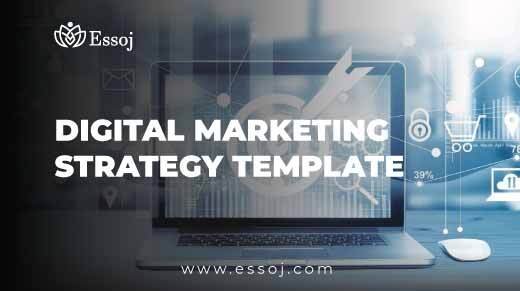In the digital age, marketing without a plan is like trying to drive across the country without a map. You might eventually get somewhere, but you’ll likely waste time, miss key opportunities, and spend more than you need to. That’s where a Digital Marketing Strategy Template becomes a game-changer.
Whether you’re running a small local shop or leading a global brand, having a smart digital strategy saves time, increases your ROI, and keeps your team focused on results. In this guide, we’ll cover everything you need to know—from defining your audience to creating content that works and measuring what matters most.
Why a Digital Marketing Strategy Is Crucial
Digital marketing isn’t just about posting on social media or sending emails. It’s about creating a cohesive plan that aligns your business goals with what your audience wants. Without a proper Digital Marketing Strategy Template, your efforts may be scattered or ineffective.
A well-designed strategy provides:
- Clarity on goals and direction
- Consistency in content and messaging
- Efficiency in team collaboration
- Focus on what truly drives results
Let’s be honest—marketing can be overwhelming. There are blogs, videos, paid ads, social media platforms, search engines, emails, influencers… and the list goes on. That’s why a strategic approach is not optional; it’s essential.
What Is a Digital Marketing Strategy Template?
A Digital Marketing Strategy Template is a structured plan that helps marketers and business owners outline their digital goals, target audience, marketing channels, budget, content plan, and performance metrics—all in one document.
This document acts as a central roadmap, guiding every decision your team makes, helping avoid random acts of marketing, and ensuring each move is deliberate and data-driven.
The Building Blocks of a Smart Digital Marketing Strategy
To help you create a results-driven strategy, let’s break down each step in detail. These steps will help you build a powerful Digital Marketing Strategy Template that drives measurable outcomes.
1. Set Clear and Measurable Goals
The first step is deciding what success looks like. Without goals, you can’t measure progress or return on investment.
Start with SMART goals:
- Specific: Clearly define what you want to accomplish.
- Measurable: Use numbers or percentages to track success.
- Achievable: Make goals realistic based on resources.
- Relevant: Align with broader business objectives.
- Time-bound: Set deadlines to create urgency.
Examples:
- Generate 500 leads in 3 months
- Increase email open rates to 35%
- Grow organic web traffic by 40% in six months
2. Know Your Audience Inside and Out
The best marketing speaks directly to a specific group of people. You can’t appeal to everyone—and that’s okay. Focus on your ideal customer profile.
Ask:
- Who are they? (age, gender, profession, location)
- What are their pain points and goals?
- What platforms do they use?
- What kind of content do they engage with?
Create buyer personas—fictional yet data-backed profiles that represent your target audience. For example, if you’re selling fitness gear, one persona might be “Fitness-Minded Moms aged 30–45.”
3. Audit Your Current Digital Presence
Before building new campaigns, evaluate where your brand stands now.
Check:
- Website performance: Is it mobile-friendly, fast, SEO-optimized?
- Social media: Which platforms are working? What’s your engagement rate?
- SEO: What keywords are you ranking for? Where can you improve?
- Email campaigns: What’s your open rate, CTR, and bounce rate?
- Paid ads: Are you getting a good return on ad spend?
This audit will serve as your baseline for growth.
4. Pick the Right Marketing Channels
You don’t need to be everywhere—you just need to be where your audience is. Your Digital Marketing Strategy Template should outline which channels will give you the best reach.
Common digital channels:
- SEO (Search Engine Optimization): Attracts traffic organically through keywords.
- Social Media Marketing: Ideal for brand awareness and community building.
- Email Marketing: Great for nurturing leads and driving conversions.
- PPC (Pay-Per-Click Advertising): Perfect for fast, targeted traffic.
- Content Marketing: Builds trust through blogs, videos, and how-to guides.
- Affiliate and Influencer Marketing: Boosts brand trust through third-party voices.
Choose 2–4 core channels and go deep instead of spreading yourself too thin.
5. Create a Content Plan That Converts
Content is the fuel that powers digital marketing. But not just any content—it needs to be relevant, valuable, and aligned with your goals.
Types of content:
- Blog articles
- Videos
- Case studies
- Infographics
- Webinars
- User-generated content
- Newsletters
Your Digital Marketing Strategy Template should map content to different stages of the buyer’s journey:
- Awareness: Educational content (blogs, videos, infographics)
- Consideration: In-depth content (case studies, comparison guides)
- Decision: Trust-building content (testimonials, demos, offers)
Pro Tip: Repurpose content across formats to extend its lifespan and reach.
6. Organize with a Content Calendar
A content calendar keeps your strategy on track by showing what content will be published, where, and when.
Include:
- Topics
- Keywords
- Publish dates
- Platform details
- Responsible team member
Consistency is key. Whether it’s three posts a week or two videos a month, sticking to a schedule builds audience trust.
7. Budget Wisely
Budgeting is a crucial part of your Digital Marketing Strategy Template. Without a financial plan, costs can spiral out of control.
Consider allocating funds for:
- Paid advertising (Google Ads, Facebook Ads)
- Content production (videos, graphics, copywriting)
- SEO tools and analytics platforms
- Freelancers or agencies
- Training or courses for your team
Keep track of every dollar to ensure maximum return on investment.
8. Set Up Tracking and Analytics
You can’t improve what you don’t measure. Tracking helps you evaluate whether your efforts are actually working.
Key Performance Indicators (KPIs) to track:
- Website traffic (via Google Analytics)
- Conversion rates
- Lead generation numbers
- Social media engagement (likes, shares, comments)
- Cost per acquisition (CPA)
- Email marketing stats (open rate, CTR, unsubscribes)
Review your analytics regularly and make adjustments based on real data.
9. Optimize Continuously
Marketing isn’t a “set it and forget it” game. The best marketers constantly test, tweak, and improve.
Use A/B testing to compare headlines, emails, ad creatives, or call-to-actions. Keep an eye on competitors, trends, and customer feedback to keep your strategy fresh and effective.
Even small improvements—like changing an email subject line or CTA button color—can lead to major gains over time.
Sample Digital Marketing Strategy Template Layout
Here’s a sample layout of what your final Digital Marketing Strategy Template might look like:
| Section | Details |
|---|---|
| Goals | Increase leads by 40% in Q2 |
| Target Audience | Small business owners aged 30–55 |
| Marketing Channels | SEO, Instagram, Email Marketing |
| Content Strategy | Weekly blog posts, 2 monthly emails, daily Instagram posts |
| Budget | $1,000/month for ads + tools |
| Metrics | Traffic, engagement, lead conversion rate |
| Responsible Parties | In-house team and freelancer |
This template should be updated every quarter to reflect results, insights, and business shifts.
Real-World Story: Small Agency, Big Results
A boutique marketing agency in Austin adopted a structured Digital Marketing Strategy Template for all client work. Before using it, they spent hours creating separate plans for every campaign. With the template, everything—from audience targeting to channel strategy—was streamlined.
In one year, client satisfaction increased by 60%, and the agency doubled its revenue. The secret wasn’t working harder—it was working smarter.
Key Takeaways: What Makes a Strong Strategy
To summarize, a strong digital strategy is:
- Goal-driven
- Audience-centric
- Platform-appropriate
- Content-rich
- Consistent
- Data-backed
- Adaptable
A great Digital Marketing Strategy Template isn’t just about filling in the blanks. It’s about making informed decisions, focusing your efforts, and tracking your progress toward clear outcomes.
Final Thoughts
Digital marketing doesn’t need to be chaotic. With a smart, reusable Digital Marketing Strategy Template, you create a strong foundation that supports every campaign you launch—no matter how big or small.
It’s not just about reaching people. It’s about reaching the right people with the right message at the right time. Whether you’re managing a side hustle, a growing business, or a full-blown marketing team, success starts with a solid plan.
So take the time to build your strategy. Treat it like an investment—because that’s exactly what it is.
Quick Strategy Checklist
- Define SMART goals
- Create buyer personas
- Choose key marketing channels
- Map content to customer journey
- Schedule with a content calendar
- Set a realistic marketing budget
- Track key metrics
- Optimize regularly

